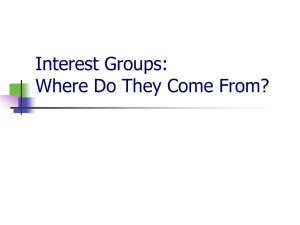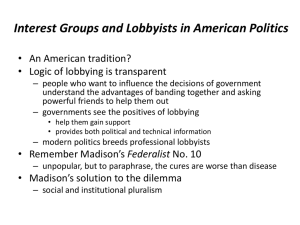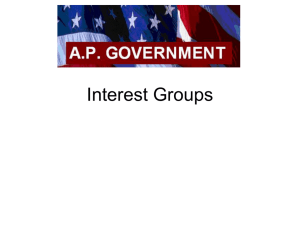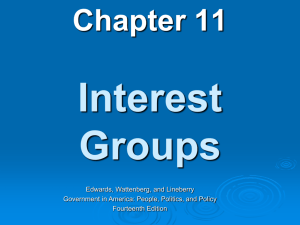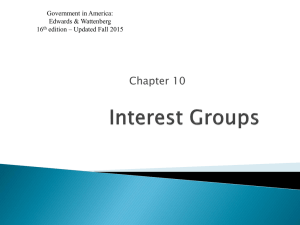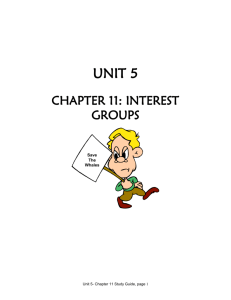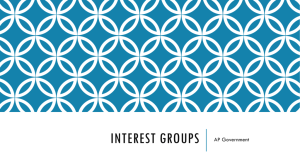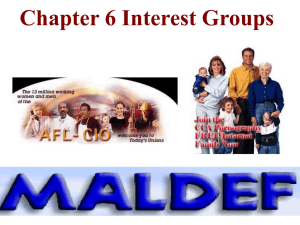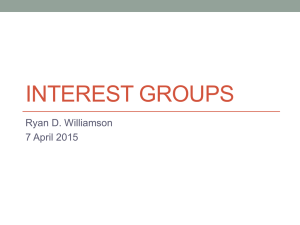10.1 Role of Interest Groups
advertisement
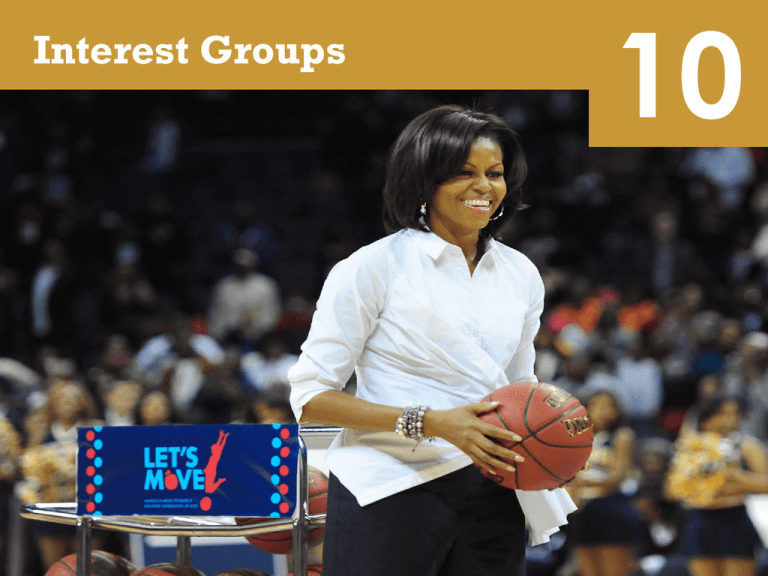
Interest Groups 10 Interest Groups “Americans of all ages, all conditions, and all dispositions constantly form associations.” - Alexis de Tocqueville Americans are more likely than citizens of other countries to participate in a civic association or community service group. Americans are more likely than others to have worked with a group to express a political view. 10 Interest Groups Are interest groups factions? 10 Role of Interest Groups 10.1 Role of Interest Groups 10.1 Interest group An organization of people with shared policy goals entering the policy process at several points to try to achieve those goals. Interest groups pursue their goals in many arenas. Policy failure in one area means trying it in another Different from political parties Do not run candidates Policy specialists, not generalists Role of Interest Groups 25,000 interest groups Technology aids lobbying 10.1 Theories of Interest Group Politics 10.2 Pluralism Pluralism A theory of government and politics emphasizing that many groups, each pressing for its preferred policies, compete and counterbalance one another in the political marketplace. Group theory of politics Groups link people and government Groups compete No one group likely to become dominant Groups play by the rules of the game Groups weak in one resource can use another Concessions Some groups stronger than others All interests do not get equal hearing 10.2 Elitism 10.2 Elitism A theory of government and politics emphasizing that many groups, each pressing for its preferred policies, compete and counterbalance one another in the political marketplace. 78% of Americans share this view Interlocking directorates Multinational corporations Lobbying benefits the few at the expense of the many Hyperpluralism 10.2 Elitism A theory of government and politics contending that groups are so strong that government, seeking to please them all, is thereby weakened. Interest group liberalism Groups out of control Government tries to appease all of them Budgets, programs, regulations expand Hyperpluralism 10.2 Iron triangles Subgovernments are composed of interest group leaders interested in a particular policy, the government agency in charge of administering that policy, and the members of committees and subcommittees handling that policy; they exercise a great deal of control over specific policy areas. Contradictory and confusing policy results What Makes an Interest Group Successful? 10.3 What Makes an Interest Group Successful? 10.3 Surprising Ineffectiveness of Large Groups Intensity Financial Resources Surprising Ineffectiveness of Large Groups Smaller groups have advantage Potential group - All the people who might be interest group members because they share some common interest. Actual group - The people in the potential group who actually join. Collective good - Something of value that cannot be withheld from a potential group member. Free-rider problem - For a group, the problem of people not joining because they can benefit form the group’s activities without joining. Selective benefits 10.3 Surprising Ineffectiveness of Large Groups Selective benefits Goods that a group can restrict to those who actually join. This can encourage potential members to become actual members 10.3 Intensity Psychological advantage Helps preserve the status quo Single-issue groups Groups that have a narrow interest, tend to dislike compromise, and often draw membership from people new to politics. 10.3 Financial Resources 10.3 System is biased toward wealthy 2008 federal elections cost $5 billion Donations lead to access But $$$ does not always lead to lobbying success Other side contributes, too How Groups Try to Shape Policy 10.4 Lobbying 10.4 Lobbying According to Lester Milbrath, a “communication, by someone other than a citizen acting on his or her own behalf, directed to a government decision maker with the hope of influencing his or her decision.” Temporary employee Two types of lobbyists Full-time employee Temporary employee Often former legislators Lobbying Ways lobbyists help Provide information Help politicians with political strategy for getting legislation through Help formulate campaign strategy and get the group’s members behind a politician’s reelection campaign A source of ideas and innovations 10.4 FIGURE 10.1: Industries’ big spenders on lobbying, 2009-2011 10.4 Electioneering Electioneering Direct group involvement in the electoral process, for example, by helping to fund campaigns, getting members to work for candidates, and forming political action committees. Aiding candidates financially Getting out the vote PACs $5,000 limit in primary and general election Mainly support incumbents 10.4 Litigation Suing for enforcement Environmental regulations Civil rights groups – 1950s Amicus curiae briefs Class action lawsuits 10.4 Going Public Public opinion influences policy makers Mobilize public opinion Public relations 10.4 Interest group ad 10.4 Types of Interest Groups 10.5 Economic Interests Labor Unions Goal is to get better working conditions and higher wages Declining in membership due to international competition and better non-unionized jobs 10.5 Economic Interests 10.5 Union shop A provision found in some collective bargaining agreements requiring all employees of a business to join the union within a short period, usually 30 days, and to remain members as a condition of employment. Right-to-work laws A state law forbidding requirements that workers must join a union to hold their jobs. State right-to-work laws were specifically permitted by the Taft-Hartley Act of 1947. Wisconsin collective bargaining fight 10.5 Economic Interests Business Dominate lobbying and PACs Business interests not monolithic Policy differences among industries 10.5 FIGURE 10.2: How corporate PACs have shifted toward the majority party 10.5 Environmental Interests Sprang up since 1970 More than 10,000 groups with $2.9 billion revenue Profound policy impact Influential due to numbers, not money 10.5 Save the polar bear 10.5 Equality Interests Fourteenth Amendment guarantees Minorities NAACP/Brown v. Board of Education (1954) Social welfare policies Women National Organization for Women (NOW) Equal Rights Amendment (ERA) 10.5 Consumer and Other Public Interest Lobbies Public interest lobbies According to Jeffery Berry, organizations that seek “a collective good, the achievement of which will not selectively and materially benefit the membership or activists of the organization.” Policies in the public interest Collective goods What is the public interest? 10.5 Understanding Interest Groups 10.6 Interest Groups and Democracy Does pluralism prevail? Growth in number of interest groups Less clout for any one group Interest group corruption? Business PACs Wealthy groups dominate Gridlock? 10.6 Interest Groups and the Scope of Government Individualistic and associational Difficult to reduce spending Vicious circle Groups lead to policy Policy prompts new groups to form 10.6


